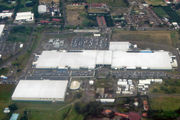Costa Rica
- For the plant genus Costarica, see its synonym Sicyos.
| Republic of Costa Rica
República de Costa Rica
|
||||||
|---|---|---|---|---|---|---|
|
||||||
| Motto: "Vivan siempre el trabajo y la paz" (Spanish) "Long live work and peace" |
||||||
| Anthem: Noble patria, tu hermosa bandera (Spanish) Noble homeland, your beautiful flag 1 |
||||||
.svg.png) |
||||||
| Capital (and largest city) |
San José |
|||||
| Official language(s) | Spanish | |||||
| Recognised regional languages | Mekatelyu, Bribri | |||||
| Demonym | Costa Rican; Tico | |||||
| Government | Constitutional democracy (Presidential republic) |
|||||
| - | President | Laura Chinchilla | ||||
| Independence | Declared | |||||
| - | from Spain | September 15, 1821 | ||||
| - | from Mexico | October 4, 1824 | ||||
| - | from UPCA | March 21, 1847 | ||||
| - | Recognized by Spain | May 10, 1850 | ||||
| Area | ||||||
| - | Total | 51,100 km2 (128th) 19,653 sq mi |
||||
| - | Water (%) | 0.7 | ||||
| Population | ||||||
| - | July 2009 estimate | 4,253,897[1] (123rd) | ||||
| - | Density | 85/km2 (107th) 220/sq mi |
||||
| GDP (PPP) | 2009 estimate | |||||
| - | Total | $48.881 billion[2] | ||||
| - | Per capita | $10,579[2] | ||||
| GDP (nominal) | 2009 estimate | |||||
| - | Total | $29.318 billion[2] | ||||
| - | Per capita | $6,345[2] | ||||
| Gini (2007) | 48.0[1] (high) (30th) | |||||
| HDI (2007) | ||||||
| Currency | Costa Rican colón (CRC) |
|||||
| Time zone | CTZ (UTC-6) | |||||
| Drives on the | right | |||||
| Internet TLD | .cr | |||||
| Calling code | +506 | |||||
Costa Rica (pronounced /ˌkoʊstə ˈrikə/ (![]() listen)), officially the Republic of Costa Rica (Spanish: Costa Rica or República de Costa Rica, pronounced [reˈpuβlika ðe ˈkosta ˈrika]) is a country in Central America, bordered by Nicaragua to the north, Panama to the east and south, the Pacific Ocean to the west and south and the Caribbean Sea to the east.
listen)), officially the Republic of Costa Rica (Spanish: Costa Rica or República de Costa Rica, pronounced [reˈpuβlika ðe ˈkosta ˈrika]) is a country in Central America, bordered by Nicaragua to the north, Panama to the east and south, the Pacific Ocean to the west and south and the Caribbean Sea to the east.
Costa Rica, which means "Rich Coast", constitutionally abolished its army permanently in 1949.[3][4][5] It is the only Latin American country included in the list of the world’s 22 older democracies.[6] Costa Rica has consistently been among the top Latin American countries in terms of the Human Development Index, and ranked 54th in the world in 2007.[7] The country is ranked 3rd in the world, and 1st among the Americas, in terms of the 2010 Environmental Performance Index.[8]
In 2007 the Costa Rican government announced plans for Costa Rica to become the first carbon neutral country by 2021.[9][10][11] According to the New Economics Foundation, Costa Rica ranks first in the Happy Planet Index and is the "greenest" country in the world.[12]
Contents |
History
In pre-Columbian times the indigenous people of Costa Rica were part of the international Intermediate Area located between the Mesoamerican and Andean cultural regions. This has recently been updated to include the influence of the Isthmo-Colombian area. This was the point where the Mesoamerican and South American native cultures met.
The northwest of the country, the Nicoya Peninsula, was the southernmost point of the Nahuatl cultural influence when the Spanish conquerors (conquistadores) arrived in the sixteenth century. The central and southern portions of the country had Chibcha influences. However, the indigenous people have influenced modern Costa Rican culture to a relatively small degree, as most of them died from diseases such as smallpox[13] and mistreatment by the Spanish colonizers.
The first European to reach contemporary Costa Rica was Christopher Columbus in 1502.[14] During Spanish Colonial times, the largest city in Central America was Guatemala City. Costa Rica's distance from this hub led to difficulty in establishing trade routes and was one of the reasons that Costa Ricans developed in relative isolation and with little oversight from the Spanish Monarchy ("The Crown"). Although this isolation allowed the colony to develop free of intervention by The Crown, it also contributed to its failure to share in the prosperity of the Colonies.[15] Costa Rica was described as "the poorest and most miserable Spanish colony in all America" by a Spanish governor in 1719.[16]
A factor in this poverty was the lack of indigenous people used as forced labor. Although many Spaniards in the other colonies had tribal members working on their land, most of the Costa Rican settlers had to work on their own land themselves. For all these reasons Costa Rica was by and large unappreciated and overlooked by the Crown and left to develop on its own. It is believed that the circumstances during this period led to the formation of many of the idiosyncrasies for which Costa Rica has become known, whereas concomitantly setting the stage for Costa Rica's development as a more egalitarian society than the rest of its neighbors. Costa Rica became a "rural democracy" with no oppressed mestizo or indigenous class. It was not long before Spanish settlers turned to the hills, where they found rich volcanic soil and a climate that was milder than that of the lowlands.[17]
Costa Rica joined other Central American provinces in 1821 in a joint declaration of independence from Spain. After a brief time in the Mexican Empire of Agustín de Iturbide Costa Rica became a state in the Federal Republic of Central America from 1823 to 1839. In 1824 the capital was moved to San José, but violence briefly ensued through an intense rivalry with Cartago. Although the newly independent provinces formed a federation, border disputes broke out among them, adding to the region's turbulent history and conditions.

Costa Rica's membership in the newly formed Federal Republic of Central America, free of Spanish rule, was short-lived; in 1838, long after the Central American Federation ceased to function in practice, Costa Rica formally withdrew and proclaimed itself sovereign. The distance from Guatemala City to the Central Valley of Costa Rica, where most of the population lived and still lives, was great. The local population had little allegiance to the government in Guatemala City, in part because of the history of isolation during Colonial times. Costa Rica's disinterest in participating as a province in a greater Central American government was one of the deciding factors in the break-up of the fledgling federation into independent states, which still exist today. However, all of the Central American nations still celebrate September 15 as their independence day, which pertains to the independence of Central America from Spain.
Most Afro-Costa Ricans, who constitute about 3% of the country's population, descend from Jamaican immigrants who arrived during the 1880s to work in the construction of railways connecting the urban populations of the Central Plateau to the port of Limón on the Caribbean coast.[18] United States convicts and Chinese immigrants also participated in the construction project, conducted by U.S. businessman Minor C. Keith. In exchange for completing the railroad, the Costa Rican government granted Keith large tracts of land and a lease on the train route, which he used to produce bananas and export them to the United States. As a result, bananas came to rival coffee as the principal Costa Rican export, while foreign-owned corporations (including the United Fruit Company) began to hold a major role in the national economy.
20th century
Historically, Costa Rica has generally enjoyed greater peace and more consistent political stability compared with many of its fellow Latin American nations. Since the late nineteenth century, however, Costa Rica has experienced two significant periods of violence. In 1917–19, Federico Tinoco Granados ruled as a dictator until he was overthrown and forced into exile. Again in 1948, José Figueres Ferrer led an armed uprising in the wake of a disputed presidential election. With more than 2,000 dead, the resulting 44-day Costa Rican Civil War was the bloodiest event in Costa Rica during the twentieth-century.
Afterwards, the new, victorious government junta, led by the opposition, abolished the military and oversaw the drafting of a new constitution by a democratically elected assembly. Having enacted these reforms, the regime finally relinquished its power on November 8, 1949, to the new democratic government. After the coup d'état, Figueres became a national hero, winning the country's first democratic election under the new constitution in 1953. Since then, Costa Rica has held 13 presidential elections, the latest being in 2010. All of them have been widely regarded by the international community as peaceful, transparent, and relatively smooth transitions.
Geography
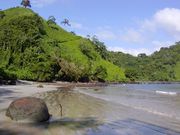
Costa Rica is located on the Central American isthmus, 10° North of the equator and 84° West of the Prime Meridian. It borders the Caribbean Sea (to the east) and the Pacific Ocean (to the west), with a total of 1,290 kilometres (800 mi) of coastline, 212 km (132 mi) on the Caribbean coast and 1,016 km (631 mi) on the Pacific.
Costa Rica also borders Nicaragua to the north (309 km or 192 mi of border) and Panama to the south-southeast (639 km or 397 mi of border). In total, Costa Rica comprises 51,100 square kilometres (19,700 sq mi) plus 589 square kilometres (227 sq mi) of territorial waters.
The highest point in the country is Cerro Chirripó, at 3,819 metres (12,530 ft), and is the fifth highest peak in Central America. The highest volcano in the country is the Irazú Volcano (3,431 m or 11,257 ft). The largest lake in Costa Rica is Lake Arenal.
Costa Rica also comprises several islands. Cocos Island (24 square kilometres / 9.3 square miles) stands out because of its distance from continental landmass, 300 mi (480 km) from Puntarenas, but Calero Island is the largest island of the country (151.6 square kilometres / 58.5 square miles). Costa Rica protects 23% of its national territory within the Protected Areas system. It also possesses the greatest density of species in the world.[19]
Climate
Because Costa Rica is located between nine to ten degrees north of the Equator, the climate is tropical year round. However, the country has many microclimates depending on elevation, rainfall, topography, and by the geography of each particular region.
Costa Rica's seasons are defined by how much it rains during a particular period and not to the four seasons in the Northern Hemisphere. The year can be split into two periods, the dry season known to the residents as summer, and the rainy season, known locally as winter. The "summer" or dry season goes from December to April, and "winter" or rainy season goes from May to November, which almost coincides with the Atlantic hurricane season, and during this time it rains constantly in some regions.
The location that receives the most rain is the Caribbean slopes of the Central Cordillera mountains, with an annual rainfall of over 5,000 mm (196.9 in). Humidity is also higher on the Caribbean side than on the Pacific side. The mean annual temperature on the coastal lowlands is around 80 °F (26.7 °C), 69 °F (20.6 °C) in the main populated areas of the Central Cordilera, and below 50 °F (10 °C) on the summits of the highest mountains.
Government
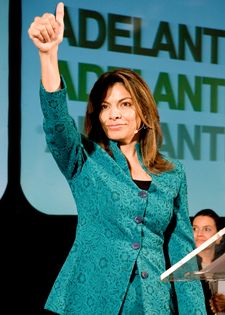
Costa Rica is a democratic republic with a strong constitution. The country has had at least 59 years of uninterrupted democracy, making it one of the most stable countries in the region, and the only Latin American country included in the list of the world’s 22 older democracies since at least 1950.[6] Costa Rica has been able to avoid the widespread violence that has plagued most of Latin America.
Costa Rica is a republic with three powers: executive responsibilities are vested in a president, legislative power is vested on the Legislative Assembly, and Judicial power is vested on the Supreme Court. There are two vice presidents as well as a cabinet designated by the president. The president, vice presidents, and 57 Legislative Assembly delegates are elected for four-year terms. A constitutional amendment approved in 1969 limited presidents and delegates to one term, although delegates are allowed to run again for an Assembly seat after sitting out a term.
The Supreme Electoral Body, the Office of the Comptroller General, the Office of the Procurator General of the Republic, and the Office of the Ombudsman also enjoy a lot of independence.
The Supreme Court is divided into four chambers, one dealing with Constitutional Law, one dealing with Criminal Law, and two dealing with Civil Law, Merchant Law and the like.
In April 2003, the constitutional amendment ban on presidential re-election was reversed, allowing Óscar Arias (Nobel Peace Prize laureate, 1987) to run for president for a second term. In 2007, Óscar Arias was elected in a tight and highly contested election, running on a platform promoting free trade. He was succeeded by Laura Chinchilla who won the election of February 7, 2010, and took office on May 8, 2010. She is also from the National Liberation Party and is the first woman to be elected president of the country.
In 2009, the state monopoly on insurance and telecommunications were opened to private-sector competition. Certain other state agencies enjoy considerable operational independence and autonomy; they include the electrical power, the nationalized commercial banks (which are open to competition from private banks), and the social security agency, all of which have played an important role in the development of the Costa Rican high-indexed quality of life.
Provinces, cantons, and districts
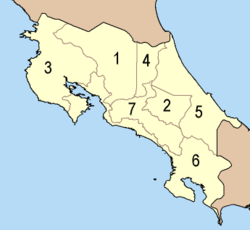
Costa Rica is composed of seven provinces, which in turn are divided into 81 cantons ("cantón" in Spanish, plural "cantones"), each of which is directed by a mayor. Mayors are chosen democratically every four years by each canton's people. There are no provincial legislatures. The cantons are further divided into districts (distritos). The provinces are:
- Alajuela
- Cartago
- Guanacaste
- Heredia
- Limón
- Puntarenas
- San José
Economy
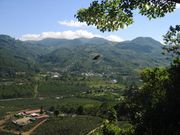
According to the World Bank, Costa Rica's GDP per capita is US$11,240 PPP (as of 2008); however, this developing country still faces the fourth highest inflation rate in Latin America, lack of maintenance and new investment in infrastructure, a poverty rate estimated to be 5% to 8%,[20][21] a 5.6% unemployment rate (2008 est.),[20] and a trade deficit of 5.2%. For the fiscal year 2007, the country showed a government surplus. Economic growth in 2008 diminished to a 3% increase in the face of a global recession (down from 7% and 9% growth in the prior 2 years).[20][22]
Costa Rica's inflation rate was an estimated 9.3% in 2007 and increased to 13.9% in 2008, Latin America's 4th highest inflation rate for both years.[20] On October 16, 2006, a new currency exchange system was introduced, allowing the value of the CRC colón to float between two bands as done previously by Chile. The idea is that by doing so the Central Bank will be able to better tackle inflation and discourage the use of U.S. dollars. However, as of August 2009, the value of the colón against the dollar has decreased to 86% of its late-2006 value (see commonly available forex trading charts). The unit of currency is the colón, and as of April 2010 it trades around 510 to the U.S. dollar,[23] and about 680 colones to the euro.
The central government offers tax exemptions for those who are willing to invest in the country. Several global high tech corporations have already started developing in the area exporting goods including chip manufacturer Intel, pharmaceutical company GlaxoSmithKline, and consumer products company Procter & Gamble. In 2006 Intel's microprocessor facility alone was responsible for 20% of Costa Rican exports and 4.9% of the country's GDP.[24][25] Trade with South East Asia and Russia boomed during 2004 and 2005, and the country obtained full Asia-Pacific Economic Cooperation Forum (APEC) membership in 2007 after becoming an observer in 2004.
In recent times pharmaceuticals, financial outsourcing, software development, and ecotourism have become the prime industries in Costa Rica's economy. High levels of education among its residents make the country an attractive investing location. Since 1999, tourism earns more foreign exchange than the combined exports of the country's three main cash crops: bananas, pineapples and coffee.[26] Coffee production has played a key role in Costa Rica's history and economy and by 2006 was the third cash crop export.[26]
The largest coffee growing areas are in the provinces of San José, Alajuela, Heredia, Puntarenas, and Cartago. Costa Rica is famous for its gourmet coffee beans, with Costa Rican Tarrazú among the finest Arabica coffee beans in the world used for making espresso coffee, together with Jamaican Blue Mountain, Guatemalan Antigua and Ethiopian Sidamo.[27][28][29][30]
Costa Rica's location provides access to American markets as it has the same time zone as the central part of the United States and direct ocean access to Europe and Asia. In a countrywide referendum on October 7, 2007, the voters of Costa Rica narrowly backed a free trade agreement, with 51.6% of "Yes" votes.[31]
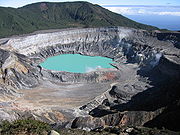
With a $2.2 billion per year tourism industry, Costa Rica is the most visited nation in the Central American region, with two million foreign visitors in 2008,[32] which translates into a relatively high expenditure per tourist of $1,077 per trip, and a rate of foreign tourists per capita of 0.46, one of the highest in the Caribbean Basin. In 2008 most visitors came from the United States (38.6%), neighboring Nicaragua (21.8%), Europe (11.3%) and Canada (5.2%).[33] In 2005, tourism contributed 8.1% of the country's GNP and represented 13.3% of direct and indirect employment.[34] Tourism now earns more foreign exchange than bananas and coffee combined.[26][35]
Costa Rica has gambling casinos. Also the United States and Costa Rica settled a dispute after the USA banned Costa Rican online poker. As compensation, the USA offered Costa Rica greater access to other service markets, including research and development, storage, technical testing and analysis. The settlement was after the country filed for arbitration at the World Trade Organization. "The agreement has been satisfactory for the country," said Foreign Trade Minister Marco Ruiz in a written statement.
Ecotourism draws many tourists to visit the extensive national parks and protected areas around the country. Costa Rica was a pioneer in this type of tourism, and the country is recognized as one of the few with real ecotourism.[36] In the 2009 Travel and Tourism Competitiveness Index, Costa Rica ranked 42nd in the world and first among Latin American countries.[37] Just considering the sub-index natural resources, Costa Rica ranks 6th worldwide in terms of the natural resources pillar, but 89th in terms of its cultural resources.
Foreign affairs
Costa Rica is an active member of the United Nations and the Organization of American States. The Inter-American Court of Human Rights and the United Nations University of Peace are based in Costa Rica. Costa Rica is also a member of many other international organizations related to human rights and democracy.
A main foreign policy objective of Costa Rica is to foster human rights and sustainable development as a way to secure stability and growth.
Costa Rica is a member of the International Criminal Court, without a Bilateral Immunity Agreement of protection for the United States military (as covered under Article 98).
Costa Rica also has a long-term disagreement with Nicaragua over the San Juan River which defines the border between the two countries; the disagreement arises because the river, on Nicaraguan soil, is the only way to reach several communities in Costa Rica served by the Costa Rican police.
On July 13, 2009, the Hague(ICJ) court stated that The Costa Ricans had their rights to navigate for commercial purposes upheld and the right to subsistence fishing on their side of the river. An 1858 treaty extended navigation rights to Costa Rica, but Nicaragua denied that passenger travel and fishing were part of the deal, the court ruled that Costa Ricans on the river were not required to have Nicaraguan tourist cards or visas as Nicaragua alleged but, in a nod to the Nicaraguans, ruled that Costa Rican boats and passengers have to stop at the first and last Nicaraguan port along their route. They must also have an identity document or passport. Nicaragua can also impose timetables on Costa Rican traffic. Nicaragua may require Costa Rican boats to display the flag of Nicaragua but may not charge them for departure clearance from its ports. These were all specific items of contention brought to the court in the 2005 filing.[38]
On June 1, 2007, Costa Rica broke diplomatic ties with the Republic of China in Taiwan, switching recognition to the People's Republic of China. President Óscar Arias Sánchez admitted the action was a response to economic exigency.[39]
Costa Rica finished a term on the United Nations Security Council, having been elected for a non-renewable two-year term in the 2007 election. Its term expired on 31 December 2009; this was Costa Rica's third time on the Security Council.
Flora and fauna

Costa Rica is home to a rich variety of plants and animals. While the country has only about 0.25% of the world's landmass, it contains 5% of the world's biodiversity.[40][41] Around 25% of the country's land area is in protected national parks and protected areas,[42][43] the largest percentage of protected areas in the world.[44][45]
One national park that is internationally renowned among ecologists for its biodiversity (including big cats and tapirs) and where visitors can expect to see an abundance of wildlife is the Corcovado National Park.[46][47] Corcovado is the one park in Costa Rica where all four Costa Rican monkey species can be found.[48] These include the White-headed Capuchin, the Mantled Howler and the endangered Geoffroy's Spider Monkey.[48][49] They also include the Central American Squirrel Monkey, which is found only on the Pacific coast of Costa Rica and a small part of Panama, and was considered endangered until 2008 when its status was upgraded to vulnerable.[50]

Tortuguero National Park—the name Tortuguero can be translated as "Full of Turtles"—is home to spider, howler, and white-throated Capuchin monkeys; the three-toed sloth and two-toed sloth; 320 species of birds; and a variety of reptiles. The park is recognized for the annual nesting of the endangered green turtle and is the most important nesting site for the species. Giant leatherback, hawksbill, and loggerhead turtles also nest there.
The Monteverde Cloud Forest Reserve is home to about 2,000 plant species,[51] including numerous orchids. Over 400 types of birds and over 100 species of mammals can be found there.[51]
As a whole, around 800 species of birds have been identified in Costa Rica. The Instituto Nacional de Biodiversidad is allowed to collect royalties on any biological discoveries of medical importance.
Costa Rica and parts of Panama are home to the vulnerable Central American Squirrel Monkey. Deforestation, illegal pet-trading, and hunting are the main reasons for its threatened status.
Costa Rica is a center of biological diversity for reptiles and amphibians, including the world's fastest running lizard, the spiny-tailed iguana (Ctenosaura similis).[52]
Demographics
As of 2010, Costa Rica has an estimated population of 4,640,000.[53] Whites and mestizos make up 94% of the population , while 3% are Black/Afro-Caribbean, 1% Native American, 1% Chinese, and 1% other.[54] The white population, is primarily of Spaniard ancestry[55] with significant numbers of Italian, German, English, Dutch, French, Irish, Portuguese, Lebanese and Polish families, as well a sizable Jewish community.
Just under 6% of the population is of black African descent. The majority of the Afro-Costa Ricans are Creole English-speaking descendants of nineteenth century black Jamaican immigrant workers, as well as slaves who were brought during the Atlantic slave trade.
There are also over 60,000 Native American or indigenous inhabitants, representing 1.5% of the population. Most of them live in secluded reservations, distributed among eight ethnic groups: Quitirrisí (In the Central Valley), Matambú or Chorotega (Guanacaste), Maleku (Northern Alajuela), Bribri (Southern Atlantic), Cabécar (Cordillera de Talamanca), Guaymí (Southern Costa Rica, along the Panamá border), Boruca (Southern Costa Rica) and Térraba (Southern Costa Rica).
There is also an expatriate community of people from the United States, Canada, Germany, Netherlands, Britain, and other countries.
Costa Rica hosts many refugees, mainly from Colombia and Nicaragua. As a result of that and illegal immigration, an estimated 10-15% (400,000–600,000) of the Costa Rican population is made up of Nicaraguans.[56][57] Some Nicaraguans migrate for seasonal work opportunities and then return to their country. Costa Rica took in many refugees from a range of other Latin American countries fleeing civil wars and dictatorships during the 1970s and 80s, notably from Chile and Argentina, as well as people from El Salvador who fled from guerrillas and government death squads.[58]
According to the World Bank, about 441,000 immigrants live legally in the country, the majority of them Nicaraguans, while 127,060 Costa Ricans live abroad, in the following countries United States, Panama, Nicaragua, Spain, Mexico, Canada, Germany, Venezuela, Dominican Republic, Guatemala..[59]
Health
The World Bank estimates that the life expectancy at birth for Costa Ricans at 2008 is 79 years, a figure unchanged since 2005.[60]
Costa Rica has been cited in various journals as Central America's great health success story. With a per capita GDP a fraction of the United States, its health care system is ranked higher. [61] Prior to 1940, government hospitals and charities provided most health care delivery. But since the 1941 creation of the Social Security Administration (CCSS; Caja Costarricense de Seguro Social), Costa Rica has provided universal health care to its wage earning residents, with coverage extended to dependants over time. In 1973, the CCSS took over administration of all 29 of the country's public hospitals and all health care, also launching a Rural Health Program (Programa de Salud Rural) for primary care to rural areas, later extended to primary care services nationwide. In 1993, laws were passed to enable elected health boards that represented health consumers, social security representatives, employers, and social organizations. By the year 2000, social health insurance coverage was available to 82% of the Costa Rican population. Each health committee manages an area equivalent to one of the 83 administrative cantons of Costa Rica. There is Limited use of private, for-profit services (around 14.4% of the national total health expenditure). About 7 % of GDP is allocated to the health sector, and over 70% is government funded. There are some threats to the universal health care model. In 2003 Costa Rica abstained from the Central American Free Market Agreement (CAFTA) discussions due to the US condition of opening up the insurance market including health insurance.
Primary health Care facilities in Costa Rica include health clinics with a general practitioner, nurse, clerk, pharmacist and a primary health technician, around one per 5000 population. In 2008 there were 5 specialty national hospitals, 3 general national hospitals, 7 regional hospitals, 13 peripheral hospitals, and 10 major clinics serving as referral centers for primary care clinics, which also deliver biopsychosocial services, family and community medical services and promotion and prevention programs. Patients can choose private health care to avoid waiting lists.
Costa Rican health professionals are well-paid in the national context and have high social prestige. In 2002 there were 0.58 new general practitioner consultations and 0.33 new specialist consultations per capita and a hospital admission rate of 8.1%.
Preventative health care is also successful. In 2002, 96% of Costa Rican women used some form of contraception, and antenatal care services provided to 87% of all pregnant women. All children under one have access to well-baby clinics and the immunization coverage rate in 2002 was above 91% for all antigens.
Costa Rica has a very low malaria incidence of 48 per 100 000 in 2000 and no reported cases of measles in 2002.
Although 40% of Costa Ricans live in rural areas, in 2002, only 9.5% of the population was below the $2 per day income poverty level and only 2.0% below $1 per day (vs 22.6% and 8.2%, respectively, in Colombia and 26.3% and 9.9% in Mexico). Ninety-five percent of the population has access to drinking water. The infant mortality rate was 9 per 1000, representing a 7-times reduction over a 3-decade span.
Costa Rica does not have armed forces and this is credited with the country's very high public expenditure on health and education.
The perinatal mortality rate dropped from 12.0 per 1000 in 1972 to 5.4 per 1000 in 2001.
Religion
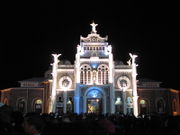
Christianity is the predominant religion, and Roman Catholicism is the official state religion according to the 1949 Constitution, which at the same time guarantees freedom of religion.
According to the most recent nationwide survey of religion, conducted in 2007 by the University of Costa Rica, 70.5% of Costa Ricans are Roman Catholics, 44.9% of the population are practicing Catholics, 13.8% are Evangelical Protestants (many of them Pentecostal), 11.3% report that they do not have a religion, and 4.3% belonged to another.
Because of the recent small but continuous immigration from Asia and the Middle East, other religions have grown, the most popular being Buddhism (because of a growing Chinese community of 40,000), and smaller numbers of Hindu, Jewish, Bahá’í, and Muslim adherents.
The Sinagoga Shaarei Zion synagogue [63] is near La Sabana Metropolitan Park in San José. Several homes in the neighborhood east of the park display the Star of David and other Jewish symbols.[64]
The Church of Jesus Christ of Latter-day Saints (Mormons) claim more than 35,000 members and has a temple in San Jose that served as a regional worship center for Costa Rica, Panama, Nicaragua, and Honduras.[65] However, they represent less than 1 percent of the population.[66][67]
Languages
The primary language spoken in Costa Rica is Spanish. Some native languages are still spoken in indigenous reservations, and a Creole-English language (also known as Mekatelyu) is spoken in the Caribbean coast. Around 10.7% of Costa Rica's adult population (18 or older) also speaks English, 0.7% French, and 0.3% speaks Portuguese or German as a second language.[68]
Culture
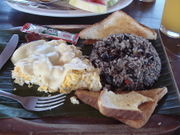
Costa Rica was the point where the Mesoamerican and South American native cultures met. The northwest of the country, the Nicoya peninsula, was the southernmost point of Nahuatl cultural influence when the Spanish conquerors (conquistadores) came in the sixteenth century. The central and southern portions of the country had Chibcha influences. The Atlantic coast, meanwhile, was populated with African workers during the seventeenth and eighteenth centuries.
Costa Rican cuisine is a blend of Native American, Spanish, African and many other cuisine origins. Dishes like the very traditional tamal and many other made of corn are the most representative of its indigenous inhabitants, and similar to other neighboring Mesoamerican countries. Spaniards brought many new ingredients to the country from other lands, specially spices and domestic animals. And later in the 19th century, the African flavor did its presence with influence from other Caribbean mixed flavors. This is how Costa Rican cuisine today is very varied, with every new ethnic group who had recently become part of the country's population influencing the country's cuisine.
As a result of the immigration of Spaniards, their 16th century Spanish culture and its evolution marked everyday life and culture until today, with Spanish language and the Catholic religion as primary influences.
The Department of Culture, Youth, and Sports is in charge of the promotion and coordination of cultural life. The work of the department is divided into Direction of Culture, Visual Arts, Scenic Arts, Music, Patrimony and the System of Libraries. Although the department creates many initiatives, they are constrained by lack of resources. Permanent programs, such as the National Symphony Orchestra of Costa Rica and the Youth Symphony Orchestra, are conjunctions of two areas of work: Culture and Youth.
Dance-oriented genres like soca, salsa, bachata, merengue, cumbia and Costa Rican swing are enjoyed increasingly by older rather than younger people. The guitar is popular, especially as an accompaniment to folk dances, however, the marimba was made the national instrument.
"Pura Vida" is the most recognizable phrase attached to Costa Ricans and it reflects the Costa Rican way of life. Often, people walking down the streets, or buying food at shops say hello by saying "Pura Vida" which means pure life, or good life. It can be phrased as a question or as an acknowledgement of one's presence. A recommended response to "How are you?" would be "Pura Vida"
Education
The literacy rate in Costa Rica is 97%,[69] one of the highest in Latin America. Elementary and high schools are found throughout the country in practically every community. Universal public education is guaranteed in the constitution. Primary education is obligatory, and both preschool and high school are free. There are only a few schools in Costa Rica that go beyond the 12th grade. Students who finish 11th grade receive a Costa Rican Bachillerato Diploma accredited by the Costa Rican Ministry of Education.
There are both state and private universities, with the public universities being regarded as the best in the country, as well as being one of the best means of social mobility, given the large proportion of the budget spent to subsidize students from poor families. The University of Costa Rica has been awarded the title "Meritorious Institution of Costa Rican Education and Culture". In recent years, many private universities and colleges have consolidated because demand for higher education exceeds places available in the public sector.
International rankings
| Index (Year) | Author / Editor / Source | Year of publication |
Countries sampled |
World Ranking (1) |
Ranking in Latin America(2) |
| Happy Planet Index (2.0) | New Economics Foundation[70] |
|
143 |
|
|
| Environmental Performance (2010) | Yale University[8] |
|
163 |
|
|
| Human Poverty, HPI-1 (2005)(3) | United Nations (UNDP)[71] |
|
108 |
|
|
| World Happiest Countries (2010) | Forbes.com[72] |
|
155 |
|
|
| Poverty below $2 a day (1990-2005)(4) | United Nations (UNDP)[73] |
|
71 |
|
|
| Press Freedom (2007) | Reporters Without Borders[74] |
|
169 |
|
|
| Democracy (2006) | The Economist[75] |
|
167 |
|
|
| Global Peace (2008) | The Economist[76] |
|
140 |
|
|
| Quality-of-life (2005) | The Economist[77] |
|
111 |
|
|
| World's Best Countries (2008/09) | Newsweek[78] |
|
100 |
|
|
| Travel and Tourism Competitiveness (2008) | World Economic Forum[79] |
|
130 |
|
|
| Corruption Perception (2008) | Transparency International[80] |
|
180 |
|
|
| Economic Freedom (2008) | The Wall Street Journal[81] |
|
162 |
|
|
| Human Development (2007) | United Nations (UNDP) [7] |
|
182 |
|
|
| Global Competitiveness (2008) | World Economic Forum[82] |
|
134 |
|
|
| Income inequality (1989-2007)(5) | United Nations (UNDP)[83] |
|
126 |
|
|
| Human Opportunity Index (1995-2005) (6) | World Bank[84] |
|
19 |
|
|
| Life Satisfaction Index (2006-2007) (7) | Inter-American Development Bank[85] |
|
24 |
|
|
- (1) Worldwide ranking among countries evaluated. See notes (3) and (4) also
- (2) Ranking among the 20 Latin American countries (Puerto Rico is not included).
- (3) Ranking among 108 developing countries with available data only.
- (4) Ranking among 71 developing countries with available data only. Countries in the sample suveyed between 1990-2005. Refers to population below income poverty line as define by the World Bank's $2 per day indicator
- (5) Because the Gini coefficient used for the ranking corresponds to different years depending of the country, and the underlying household surveys differ in method and in the type of data collected, the distribution data are not strictly comparable across countries. The ranking therefore is only a proxy for reference purposes.
- (6) The Human Opportunity Index study was performed by the World Bank among 19 countries in the Latin American and the Caribbean region, where statistics and census information is most reliable. Therefore, it is a regional index and there is no worldwide ranking available.
- (7) The Life Satisfaction Index study was performed by the Inter-American Development Bank among 24 countries in the Latin American and the Caribbean region, based on IDB calculations based on Gallup World Poll 2006 - 2007 and World Development Indicators. Therefore, it is a regional index.
See also
- Index of Costa Rica-related articles
- List of countries without armed forces
References
- ↑ 1.0 1.1 "Costa Rica". CIA The World Factbook. https://www.cia.gov/library/publications/the-world-factbook/geos/cs.html#top.
- ↑ 2.0 2.1 2.2 2.3 "Costa Rica". International Monetary Fund. http://www.imf.org/external/pubs/ft/weo/2010/01/weodata/weorept.aspx?sy=2007&ey=2010&scsm=1&ssd=1&sort=country&ds=.&br=1&c=238&s=NGDPD%2CNGDPDPC%2CPPPGDP%2CPPPPC%2CLP&grp=0&a=&pr.x=40&pr.y=7. Retrieved 2010-04-21.
- ↑ El Espíritu del 48. "Abolición del Ejército" (in Spanish). http://www.elespiritudel48.org/docu/h013.htm. Retrieved 2008-03-09.
- ↑ "Costa Rica". World Desk Reference. http://dev.prenhall.com/divisions/hss/worldreference/CR/defense.html. Retrieved 2009-06-09.
- ↑ "Costa Rica". Uppsala Universitet. http://www.pcr.uu.se/gpdatabase/gpcountry.php?id=39®ionSelect=4-Central_Americas. Retrieved 2009-06-09.
- ↑ 6.0 6.1 "Costa Rica's new president: Thriller for Chinchilla". The Economist. 2010-02-11. http://www.economist.com/world/americas/displaystory.cfm?story_id=15501885&fsrc=rss. Retrieved 2010-02-16.
- ↑ 7.0 7.1 UNDP Human Development Report 2009. "Table H: Human development index 2007 and its components" (PDF). UNDP. http://hdr.undp.org/en/media/HDR_2009_EN_Complete.pdf. Retrieved 2009-10-05.
- ↑ 8.0 8.1 Yale Center for Environmental Law & Policy / Center for International Earth Science Information Network at Columbia University. "2010 Environmental Performance Index". http://epi.yale.edu/Home. Retrieved 2010-01-27.
- ↑ John Burnett (2008-02-18). "Costa Rica Aims to Be a Carbon-Neutral Nation". National Public Radio (NPR.org). http://www.npr.org/templates/story/story.php?storyId=19141333. Retrieved 2009-04-27.
- ↑ Alana Herro (2007-03-12). "Costa Rica Aims to Become First "Carbon Neutral" Country". Worldwatch Institute. http://www.worldwatch.org/node/4958. Retrieved 2009-04-27.
- ↑ Alejandro Vargas (2007-02-21). "País quiere ser primera nación con balance neutro de carbono" (in Spanish). La Nación. http://www.nacion.com/ln_ee/2007/febrero/21/aldea1002694.html. Retrieved 2009-04-27.
- ↑ Ashley Seager (2008-07-04). "Costa Rica is the world's happiest and greenest country in the world.". London: Guardian.co.uk. http://www.guardian.co.uk/environment/2009/jul/04/costa-rica-happy-planet-index. Retrieved 2009-07-04.
- ↑ "The Story Of... Smallpox". Pbs.org. http://www.pbs.org/gunsgermssteel/variables/smallpox.html. Retrieved 2010-06-26.
- ↑ Geographia. Retrieved November 22, 2007.
- ↑ "A Brief History of Costa Rica: Colonial Times". http://www.horizontes.com/en/history.html. Retrieved 2007-12-21.
- ↑ Shafer, D. Michael (1994). Winners and losers: how sectors shape the developmental prospects of states. Ithaca, N.Y.: Cornell University Press. ISBN 0-8014-8188-0.
- ↑ "Costa Rica – Cartago". Costarica.com. 2009-05-22. http://www.costarica.com/Destinations/Cities-and-Towns/Cartago/. Retrieved 2010-06-26.
- ↑ "Blacks of Costa Rica". World Culture Encyclopedia. http://www.everyculture.com/Middle-America-Caribbean/Blacks-of-Costa-Rica.html. Retrieved 2007-11-23.
- ↑ "estudiofi". Inbio.ac.cr. http://www.inbio.ac.cr/es/biod/estrategia/estudio.html. Retrieved 2010-06-26.
- ↑ 20.0 20.1 20.2 20.3 "Rank Order – Inflation rate (consumer prices)". CIA World Factbook. https://www.cia.gov/library/publications/the-world-factbook/geos/cs.html. Retrieved 2008-02-14.
- ↑ http://hdr.undp.org/en/media/HDI_2008_EN_Tables.pdf
- ↑ "Costa Rica: Economy". U.S. State Department. http://www.state.gov/r/pa/ei/bgn/2019.htm. Retrieved 2007-11-02.
- ↑ "Tipo cambio de compra y de venta del dĂłlar de los Estados Unidos de AmĂŠrica". Indicadoreseconomicos.bccr.fi.cr. http://indicadoreseconomicos.bccr.fi.cr/indicadoreseconomicos/Cuadros/frmVerCatCuadro.aspx?idioma=1&CodCuadro=%20400. Retrieved 2010-06-26.
- ↑ "Intel supone el 4,9 por ciento del PIB de Costa Rica" (in Spanish). El Economista. 2006-10-06. http://eleconomista.es/empresas-finanzas/noticias/81837/10/06/Intel-supone-el-49-por-ciento-del-PIB-de-Costa-Rica.html. Retrieved 2008-04-13.
- ↑ "Intel fabrica el procesador "más veloz del mundo" en Costa Rica" (in Spanish). La Vanguardia. 2007-11-13. http://www.lavanguardia.es/premium/publica/publica?COMPID=53410660334&ID_PAGINA=22088&ID_FORMATO=9&turbourl=false. Retrieved 2008-04-13.
- ↑ 26.0 26.1 26.2 Departamento de Estadísticas ICT (2006). "Anuário Estadísticas de Demanda 2006" (in Spanish) (PDF). Intituto Costarricense de Turismo. http://www.visitcostarica.com/ict/backoffice/treeDoc/files/Anuario%20de%20Turismo%202006%20(VERSION%20FINAL).pdf. Retrieved 2008-07-29. Table 44 and 45
- ↑ Revista VEJA (2008-07-31). "Os melhores grãos do mundo" (in Portuguese). Editora Abril. http://veja.abril.com.br/300708/p_140.shtml. Retrieved 2008-07-29. Edition 2071. Print edition pp. 140
- ↑ Betty Fussell (1999-09-05). "The World Before Starbucks". The New York Times. http://query.nytimes.com/gst/fullpage.html?res=9400E0D7173BF936A3575AC0A96F958260&sec=&spon=&pagewanted=2. Retrieved 2008-07-29.
- ↑ Florence Fabricant (1992-09-02). "Americans Wake Up and Smell the Coffee". The New York Times. http://query.nytimes.com/gst/fullpage.html?res=9E0CE3DB153FF931A3575AC0A964958260&sec=&spon=&pagewanted=1. Retrieved 2008-07-29.
- ↑ "Ferris Gourmet Coffee Beans: Single origin coffees". Ferris Coffee & Nuts. http://www.ferriscoffee.com/coffee.html. Retrieved 2008-07-29.
- ↑ "Latinamerica Press". Latinamerica Press. http://www.latinamericapress.org/article.asp?lanCode=1&artCode=5348. Retrieved 2010-06-26.
- ↑ Hassel Fallas (2008-12-18). "Llegada de turistas dejará $2.200 millones este año" (in Spanish). La Nación. http://www.nacion.com/ln_ee/2008/diciembre/18/economia1815172.html. Retrieved 2009-04-27.
- ↑ Departamento de Estadísticas ICT (2009). "Anuário Estadístico 2008" (in Spanish) (PDF). Intituto Costarricense de Turismo. http://www.visitcostarica.com/ict/paginas/modEst/estudios_estadisticas.asp?idIdioma=2. Retrieved 2008-09-05.
- ↑ Altés, Carmen (2006). "El Turismo en América Latina y el Caribe y la experiencia del BID". Inter-American Development Bank; Sustainable Development Department, Technical Paper Series ENV-149, Washington, D.C. available at http://idbdocs.iadb.org/wsdocs/getdocument.aspx?docnum=984876.+p. 9 and 47
- ↑ José Enrique Rojas (2004-12-29). "Turismo, principal motor de la economía durante el 2004" (in Spanish). La Nación. http://www.nacion.com/ln_ee/2004/diciembre/29/economia0.html. Retrieved 2008-04-13.
- ↑ Honey, Martha (1999). Ecotourism and Sustainable Development: Who Owns Paradise?. Island Press; 1 edition, Washington, D.C.. p. 5. ISBN 1-55963-582-7
- ↑ Jennifer Blanke and Thea Chiesa, Editors (2009). "The Travel & Tourism Competitiveness Report 2009" (PDF). World Economic Forum, Geneva, Switzerland. http://www.weforum.org/pdf/TTCR09/TTCR09_Rankings.pdf.
- ↑ IJC Court Ruling
- ↑ Costa Rica Boots Taiwan, Welcomes China In Diplomatic Switch Date: 2007-06-14. Retrieved: 2010-05-20
- ↑ Leo Hickman (2007-05-26). "Shades of green". London: The Guardian. http://www.guardian.co.uk/travel/2007/may/26/saturday.costarica. Retrieved 2008-06-08.
- ↑ Honey, Martha (1999) (in Inglés). Ecotourism and Sustainable Development: Who Owns Paradise?. Island Press; 1 edition, Washington, D.C.. pp. 128–181. ISBN 1-55963-582-7 Chapter 5. Costa Rica: On the Beaten Path
- ↑ "United Nations Framework Convention on Climate Change. "Issues relating to reducing emissions from deforestation in developing countries and recommendations on any further process"" (PDF). http://unfccc.int/resource/docs/2006/sbsta/eng/misc05.pdf. Retrieved 2010-06-26.
- ↑ Earth Trends (2003). "Biodiversity and Protected Areas – Costa Rica" (PDF). World Resources Institute. http://earthtrends.wri.org/pdf_library/country_profiles/bio_cou_188.pdf. Retrieved 2008-06-08.
- ↑ "Costa Rica National Parks and Reserves". World Headquarters. 2007. http://www.worldheadquarters.com/cr/protected_areas/. Retrieved 2008-06-08.
- ↑ Leonardo Coutinho and Otávio Cabral (2008-05-21). "O desafio da economia verde" (in Portuguese). Revista Veja. http://planetasustentavel.abril.com.br/noticia/desenvolvimento/conteudo_280147.shtml?func=2. Retrieved 2008-06-08. Published on website "Planeta Sustentável"
- ↑ Corcovado National Park
- ↑ "Diversity of Corcovado National Park". Govisitcostarica.com. http://www.govisitcostarica.com/region/city.asp?cID=350. Retrieved 2010-06-26.
- ↑ 48.0 48.1 Hunter, L. & Andrew, D. (2002). Watching Wildlife Central America. Lonely Planet. p. 97. ISBN 1-86450-034-4.
- ↑ Cuarón, A.D., Morales, A., Shedden, A., Rodriguez-Luna, E. & de Grammont, P.C. (2008). Ateles geoffroyi. In: IUCN 2008. IUCN Red List of Threatened Species. Downloaded on 20 February 2009.
- ↑ Wong, G., Cuarón, A.D., Rodriguez-Luna, E. & de Grammont, P.C. (2008). Saimiri oerstedii. In: IUCN 2008. IUCN Red List of Threatened Species. Downloaded on 20 February 2009.
- ↑ 51.0 51.1 "Monteverde Cloud Forest Reserve". Govisitcostarica.com. http://www.govisitcostarica.com/region/city.asp?cID=402. Retrieved 2010-06-26.
- ↑ Garland, T., Jr. (1984). "Physiological correlates of locomotory performance in a lizard: an allometric approach". American Journal of Physiology 247 (5 Pt 2): R806–R815. PMID 6238543. http://www.biology.ucr.edu/people/faculty/Garland/Garl1984.pdf.
- ↑ http://esa.un.org/unpp/p2k0data.asp
- ↑ Costa Rica: Ethnic groups
- ↑ "White Settlement in Costa Rica". Links.jstor.org. https://www.cia.gov/library/publications/the-world-factbook/geos/cs.html. Retrieved 2010-06-26.
- ↑ www.state.gov Background Note: Costa Rica – People
- ↑ Dickerson, Marla; Kimitch, Rebecca (2006-03-23). "Costa Rica Seeks to Shut Its Doors to Illegal Migrants From Nicaragua". Los Angeles Times. http://articles.latimes.com/2006/mar/23/world/fg-costa23. Retrieved 2010-05-02.
- ↑ Biesanz, Karen Zubris; Biesanz, Mavis Hiltunen; Biesanz, Richard (1998). The Ticos: Culture and Social Change in Costa Rica. Boulder: Lynne Rienner Publishers. p. 118. ISBN 1-55587-737-0.
- ↑ http://siteresources.worldbank.org/INTPROSPECTS/Resources/334934-1199807908806/CostaRica.pdf
- ↑ {url=http://data.worldbank.org/country/costa-rica | title=Costa Rica Country Data | accessdate=2010-08-30}}
- ↑ Jacob, Brian (2009). "CLOSING THE GAPS: The Challenge to Protect Costa Rica's Health Care System". The Georgetown Public Policy Review (77). http://www9.georgetown.edu/grad/gppi/GPPIReview/index.cfm.
- ↑ Unger, Jean-Pierre; Buitrón, René; Soors, Werner (2008). "Costa Rica: Achievements of a Heterodox Health Policy". American Journal of Public Health 98 (4): 636-643. http://ajph.aphapublications.org/cgi/content/full/98/4/636.
- ↑ Centro Israelita de Costa Rica, Comunidad Judía de Costa Rica, Costa Rican Jewish Community
- ↑ "Jewish Community in Costa Rica". Jcpa.org. http://www.jcpa.org/dje/articles2/costarica.htm. Retrieved 2010-06-26.
- ↑ Costa Rica. LDS Newsroom. Retrieved 2008-12-13.
- ↑ "San José Costa Rica LDS (Mormon) Temple". Ldschurchtemples.com. http://www.ldschurchtemples.com/sanjose/. Retrieved 2010-06-26.
- ↑ "List of LDS (Mormon) temples in Central America and the Caribbean". Lds.org. http://www.lds.org/temples/geographical/0,11380,1899-1---19,00.html. Retrieved 2010-06-26.
- ↑ Jairo Villegas (2008-03-13). "Solo 1 de cada 10 adultos habla un segundo idioma". La Nación (Costa Rica). http://www.nacion.com/ln_ee/2008/marzo/11/pais1457622.html. Retrieved 2010-07-22.
- ↑ CIA World Factbook, January 2009
- ↑ New Economics Foundation. "The Happy Planet Index". http://www.happyplanetindex.org/public-data/files/happy-planet-index-2-0.pdf. Retrieved 2009-07-05.
- ↑ UNPD Human Development Report 2007/2008. "Table 3: Human poverty index: developing countries". http://hdr.undp.org/en/media/hdr_20072008_en_indicator_tables.pdf. Retrieved 2008-03-20. page 240
- ↑ Forbes.com. "Forbes - The World's Happiest Countries". http://www.forbes.com/2010/07/14/world-happiest-countries-lifestyle-realestate-gallup-table.html. Retrieved 2010-07-19.
- ↑ UNPD Human Development Report 2007/2008. "Table 3: Human poverty index: developing countries". http://hdr.undp.org/en/media/hdr_20072008_en_indicator_tables.pdf. Retrieved 2008-03-20. page 238-240
- ↑ Reporters Without Borders. "Worldwide Press Freedom Index 2007". http://www.rsf.org/article.php3?id_article=19387. Retrieved 2008-03-13.
- ↑ The Economist Intelligence Unit. "The World in 2007, Democracy Index 2006". http://www.economist.com/media/pdf/DEMOCRACY_INDEX_2007_v3.pdf. Retrieved 2008-03-13.
- ↑ The Economist Intelligence Unit et al. (Vision of Humanity website). "Global Peace Index Rankings". http://www.visionofhumanity.org/gpi/results/rankings/. Retrieved 2008-05-28.
- ↑ The Economist Intelligence Unit. "Pocket World in Figures 2008". http://www.economist.com/media/pdf/QUALITY_OF_LIFE.pdf. Retrieved 2008-03-13.
- ↑ Newsweek. "The World's Best Countries". http://www.newsweek.com/2010/08/15/interactive-infographic-of-the-worlds-best-countries.html. Retrieved 2010-08-21.
- ↑ World Economic Forum (2008). "The Travel & Tourism Competitiveness Report 2008". http://www.weforum.org/pdf/CGR08/Rankings.pdf. Retrieved 2008-03-09.
- ↑ Transparency International. "2008 Corruption Perception Index Ranking Table". http://www.transparency.org/news_room/in_focus/2008/cpi2008/cpi_2008_table. Retrieved 2008-09-28.
- ↑ The Heritage Foundation and The Wall Street Journal. "Index of Economic Freedom 2008". http://www.heritage.org/research/features/index/countries.cfm. Retrieved 2008-03-14.
- ↑ World Economic Forum. "The Global Competitiveness Report 2008-2009". http://gcr.weforum.org/gcr/. Retrieved 2008-10-09.
- ↑ UNPD Human Development Report 2007/2008. "Inequality in income or expenditure". http://hdrstats.undp.org/indicators/147.html. Retrieved 2008-08-05.
- ↑ World Bank Human Opportunity Index. "Measuring Inequality of Opportunities in Latin America and the Caribbean". http://siteresources.worldbank.org/LACEXT/Resources/258553-1222276310889/Book_HOI.pdf. Retrieved 2008-11-12.
- ↑ Inter-American Development Bank. "Faster Economic Growth Hurts Life Satisfaction in Latin America and the Caribbean". http://www.iadb.org/NEWS/detail.cfm?id=4859. Retrieved 2008-11-23.
Further reading
- CIA World Factbook. Costa Rica.
- Edelman, Marc. Peasants Against Globalization: Rural Social Movements in Costa Rica Stanford: Stanford University Press, 1999.
- Sebastian Huhn: Contested Cornerstones of Nonviolent National Self-Perception in Costa Rica: A Historical Approach, 2009.
- Lara, Sylvia Lara, Tom Barry, and Peter Simonson. Inside Costa Rica: The Essential Guide to Its Politics, Economy, Society and Environment London: Latin America Bureau, 1995.
- Lehoucq, Fabrice E. and Ivan Molina. Stuffing the Ballot Box: Fraud, Electoral Reform, and Democratization in Costa Rica Cambridge: Cambridge University Press, 2002.
- Lehoucq, Fabrice E. Policymaking, Parties, and Institutions in Democratic Costa Rica, 2006.
- Palmer, Steven and Iván Molina. The Costa Rica Reader: History, Culture, Politics Durham and London: Duke University Press, 2004.
- Sandoval, Carlos. Threatening Others: Nicaraguans and the Formation of National Identities in Costa Rica Athens: Ohio University Press, 2004.
- Wilson, Bruce M. Costa Rica: Politics, Economics, and Democracy: Politics, Economics and Democracy. Boulder, London: Lynne Rienner Publishers, 1998.
- Blake, Beatrice. "The New Key to Costa Rica" Berkeley, California: Ulysses Press, 2009.
External links
- Costa Rica entry at The World Factbook
- Costa Rica at UCB Libraries GovPubs
- Costa Rica at the Open Directory Project
- Wikimedia Atlas of Costa Rica
- Government and administration
- Casa Presidencial Official presidential website (Spanish)
- Official index to government websites (Spanish)
- Travel & tourism
- Costa Rica travel guide from Wikitravel
Costa Rican Mountains
|
||||||||
|
|||||||||||||||||||||||||||||||||||||
|
|||||||||||||||||
.svg.png)

.jpg)
